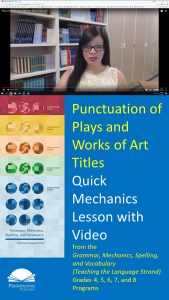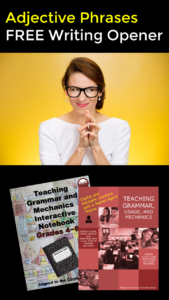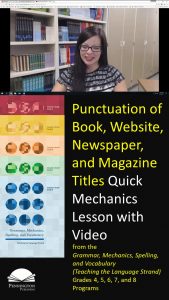Punctuation of Song and Poem Titles
Punctuation of Song and Poem Titles
Play the quick video lesson HERE and click the upper left back arrow to return to this lesson.
Common Core Language Standard 2
Punctuating song and poem titles can be a bit confusing. Both songs and poems don’t always fit into our general rules that things which are “short, part of a whole, or can’t be picked up a table” are enclosed within quotation marks and things which are “long, whole things, or can be picked up from a table” are italicized or underlined. After all, some songs and poems can be very long. Some songs and poems are not parts of a whole. You can certainly buy just one song from iTunes. Finally, how do you pick up a download from a table? It’s important to remember that rules all have exceptions.
Today’s mechanics lesson is on how to punctuate song and poem titles. Remember that any title of a creative work must be punctuated with either italics (underlining if written) or quotations.
Now let’s read the mechanics lesson and study the examples.
Place quotation marks before and after the titles of songs and poems. Songs and poems are parts of whole things, small things, or things that can’t be picked up from a table. Examples: “Jingle Bells” “This Little Piggy”
Now circle or highlight what is right and revise what is wrong according to mechanics lesson.
Practice: The lyrics to “The Star-Spangled Banner” were taken from Francis Scott Key’s poem titled Defence of Fort McHenry.
Let’s check the Practice Answers.
Mechanics Practice Answers: The lyrics to “The Star-Spangled Banner” were taken from Francis Scott Key’s poem titled “Defence of Fort McHenry.” Note that defence is the British spelling.
Now let’s apply what we have learned.
Writing Application: Write your own sentence using the title of a song.
*****

Pennington Publishing Grammar Programs
Teaching Grammar, Usage, and Mechanics (Grades 4, 5, 6, 7, 8, and High School) are full-year, traditional, grade-level grammar, usage, and mechanics programs with plenty of remedial practice to help students catch up while they keep up with grade-level standards. Twice-per-week, 30-minute, no prep lessons in print or interactive Google slides with a fun secret agent theme. Simple sentence diagrams, mentor texts, video lessons, sentence dictations. Plenty of practice in the writing context. Includes biweekly tests and a final exam.
Grammar, Usage, and Mechanics Interactive Notebook (Grades 4‒8) is a full-year, no prep interactive notebook without all the mess. Twice-per-week, 30-minute, no prep grammar, usage, and mechanics lessons, formatted in Cornell Notes with cartoon response, writing application, 3D graphic organizers (easy cut and paste foldables), and great resource links. No need to create a teacher INB for student make-up work—it’s done for you! Plus, get remedial worksheets, biweekly tests, and a final exam.
Syntax in Reading and Writing is a function-based, sentence level syntax program, designed to build reading comprehension and increase writing sophistication. The 18 parts of speech, phrases, and clauses lessons are each leveled from basic (elementary) to advanced (middle and high school) and feature 5 lesson components (10–15 minutes each): 1. Learn It! 2. Identify It! 3. Explain It! (analysis of challenging sentences) 4. Revise It! (kernel sentences, sentence expansion, syntactic manipulation) 5. Create It! (Short writing application with the syntactic focus in different genre).
Get the Diagnostic Grammar, Usage, and Mechanics Assessments, Matrix, and Final Exam FREE Resource:
![]()








